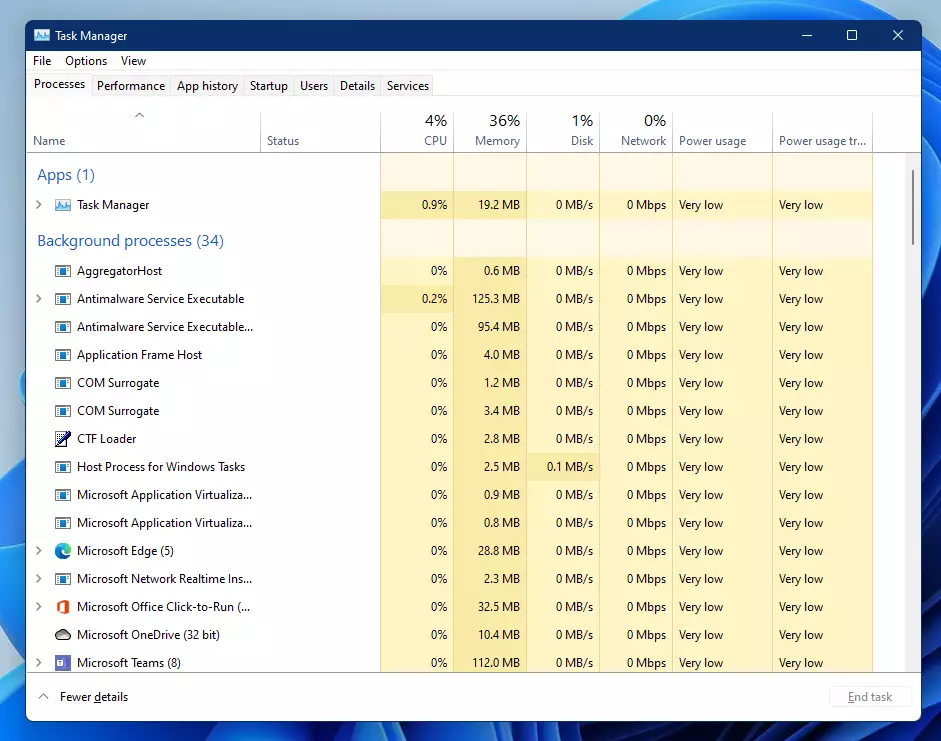This post explains how to open and use the Task Manager in Windows 11.
Task Manager has been part of Windows since early Windows NT 4.0 / 2000, and it allows users to view tasks (processes), startup programs, services, and the overall performance of the computer.
The Task Manager comes with different tabs that provide different functions and usage. In Windows 11, the Task Manager comes with these tabs: Processes, Performance, App History, Startup, Users, Details, and Services.
Below, we will provide details on each tab, what it can be used for, and how users might want to view their system performance and see what’s running in Windows to diagnose and resolve problems.
How to open the Task Manager in Windows 11
As mentioned above, the Task Manager helps determine Windows’ performance, understand tasks and processes, and how they impact your system’s performance.
There are multiple ways one can use to open the Task Manager. These are the many ways to open the Task Manager in Windows 11:
- Press CTRL + SHIFT + Esc
- Press CTRL + ALT + DELETE > then select Task Manager from the options provided
- Press CTRL + X > to open Power User Tasks menu, then select Task Manager
- Click Start menu, then search for and select Task Manager app under Best math.

Task Manager can also be opened from the command prompt in Windows. However, whatever method is used to open the Task Manager, below is a visual example of what Task Manager looks like in Windows 11.

Description of Task Manager tabs in Windows 11
When Task Manager opens, you’ll see multiple tabs. Below are some descriptions of each tab and how one can use it to diagnose and resolve issues.
- Processes: the Processes tab is the first tab visible when Task Manager opens. It shows all Windows processes currently running on the computer. In previous versions of Windows, the Processes tab was named Application. They’re both combined in Windows 11.
- Performance: the Performance tab displays the computer’s available system resources, including how much CPU, Memory, Disk, Ethernet, and/or Wi-Fi being used. Windows also shows the usage chart for each resource as they’re being used.
- App history: the App history tab shows the overall history of each of the Windows store app that have run on the computer.
- Startup: the Startup tab shows each program that starts with Windows and its impact on the system’s load. This tab is mostly used to enable or disable apps from starting up with Windows.
- Users: the User tab shows all the users logged in to the computer. One can use this tab to disconnect or log other users off the system.
- Details: the Details tab shows full details of each of the processes running on the computer.
- Services: the Services tab shows shows all the Windows Services currently running on the computer. This tab can be used to stop or end services running on the computer.
Above are some details of the Task Manager tabs in Windows 11.
The Task Manager should be easily accessible to users on the computer. It’s a useful tool for finding and resolving issues in Windows 11.
Conclusion:
- The Task Manager in Windows 11 is an essential tool for managing processes and monitoring system performance.
- Users can easily open Task Manager through various methods, making it accessible for troubleshooting and diagnostics.
- Each tab within Task Manager serves a specific purpose, from viewing running processes and system performance to managing startup applications and services.
- Understanding how to navigate and utilize these tabs can help users efficiently resolve issues and optimize their system’s performance.
- Regular use of Task Manager can improve system stability and user experience in Windows 11.

Leave a Reply Cancel reply